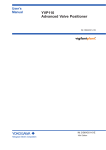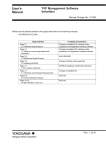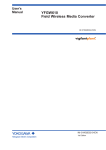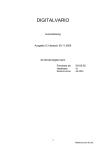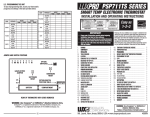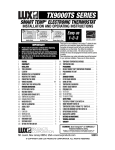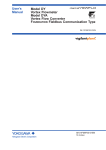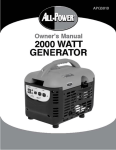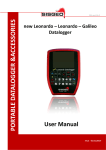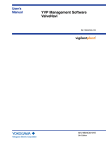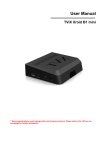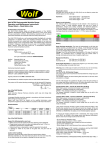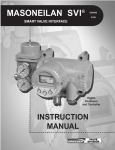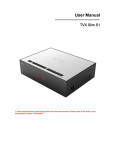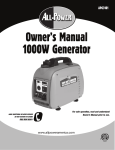Download User`s Manual YVP110 Advanced Valve Positioner
Transcript
User’s Manual YVP110 Advanced Valve Positioner Manual Change No. 13-007 Please use the attached sheets for the pages listed below in the following manuals. IM 21B04C01-01E (9th) Page and Item Contents of Correction CONTENTS CENELEC ATEX (KEMA)→ATEX Page 1-3 EMC Conformity Standards Correction Page 1-7 ATEX Certificate CENELEC ATEX (KEMA)→ATEX Page 1-9 B) ATEX Flameproof Type C) ATEX Type of Protection “n” Page 1-10 CENELEC ATEX (KEMA)→ATEX Change specifications ATEX Intrinsically safe (Ex ic) / Type n (Ex nA) Change specifications and Notes Change Notes and Installation Diagram Page 1-11 (6) Name plate Add Name plate for /KN25 Page 6-1 General CENELEC→ATEX Page 7-1 Conditions of Communication Line Change current draw Page 7-4 KF2, KS25 KN25 CENELEC ATEX (KEMA)→ATEX Change specifications Page A-13 Relative Index 52 to 55, 62 and 63 Corrections Page A-30 A4.2 Specifications Change current draw June 20, 2013 i YVP110 Advanced Valve Positioner IM 21B04C01-01E 9th Edition CONTENTS Introduction...........................................................................................................viii ■ Notes on the User’s Manual.............................................................................. viii ■ For Safe Use of Product.................................................................................... viii ■ Warranty...............................................................................................................ix ■ Trade Mark...........................................................................................................ix ■ ATEX Documentation............................................................................................x PART I: HARDWARE 1. Notes on Handling..................................................................................... 1-1 1.1 Nameplate........................................................................................................... 1-1 1.2 Transport............................................................................................................. 1-1 1.3 Storage................................................................................................................ 1-1 1.4 Choosing the Installation Location.................................................................. 1-1 1.5 Use of a Transceiver.......................................................................................... 1-1 1.6 Insulation Resistance Test and Withstand Voltage Test............................... 1-2 1.7 Notes for Saftey.................................................................................................. 1-2 1.8 EMC Conformity Standards.............................................................................. 1-3 1.9 Installation of Explosion Protected Type Positioner..................................... 1-3 1.10 2. 3. 1.9.1 FM Certification................................................................................... 1-3 1.9.2 ATEX Certification............................................................................... 1-7 1.9.3 CSA Certification............................................................................... 1-12 1.9.4 TIIS Certification............................................................................... 1-12 Low Voltage Directive...................................................................................... 1-12 Part Names................................................................................................. 2-1 2.1 Appearance and Part Names............................................................................ 2-1 2.2 Block Diagram.................................................................................................... 2-1 Installing YVP110 on Actuator................................................................. 3-1 3.1 General................................................................................................................ 3-1 3.2 Installing YVP110 on Actuator.......................................................................... 3-1 3.2.1 Installing YVP110 on Linear-motion Control Valve............................. 3-1 3.2.2 Installing YVP110 on Rotary-motion Control Valve............................ 3-3 3.2.3 A/M Switching..................................................................................... 3-5 9th Edition: Sep. 2011(KP) All Rights Reserved, Copyright © 2000, Yokogawa Electric Corporation IM 21B04C01-01E 1.8 EMC Conformity Standards or EN61326-1 Class A, Table 2 (For use in industrial locations) CAUTION This instrument is a Class A product, and it is designed for use in the industrial environment. Please use this instrument in the industrial environment only. 1.9 Installation of Explosion Protected Type Positioner CAUTION To preserve the safety of explosionproof equipment requires great care during mounting, wiring and piping. Safety requirements also place restrictions on maintenance and repair activities. Please read the following section very carefully. 1.9.1 FM Certification A) FM Intrinsically Safe Type Cautions for FM Intrinsically safe type. (Following cotents refer “Doc No. IFM017-A12 P.1, 1-1, 2, 2-1, and 2-2.”) Note 1. Model YVP110 Advenced Valve Positioner with optional code /FS15 are applicable for use in hazardous locations. • Applicable standard: FM3600, FM3610, FM3611, FM3810, ANSI/NEMA250 • Intrinsically safe, with FISCO parameters, for use in Class I, II, III, Division 1, Groups A, B, C, D, E, F, G and Class I, Zone 0, AEx ia IIC • Non-incendive for Class I, Division 2, Groups A, B, C, D and Class I, Zone 2, Group IIC • Indoor/Outdoor hazardous locations, NEMA 4X • Ambient Temperature: –40 to 60°C Note 2. Electrical Data Rating 1 For Groups A, B, C, D, E, F and G or Group IIC Maximum Input Voltage Vmax: 24 V Maximum Input Current Imax: 250 mA Maximum Input Power Pmax: 1.2 W Maximum Internal Capacitance Ci: 1.76 nF Maximum Internal Inductance Li: 0 µH 1-3 <1. Notes on Handling> or Rating 2 For Groups A, B, C, D, E, F and G or Group IIC Maximum Input Voltage Vmax: 17.5 V Maximum Input Current Imax: 360 mA Maximum Input Power Pmax: 2.52 W Maximum Internal Capacitance Ci: 1.76 nF Maximum Internal Inductance Li: 0 µH Rating 3 For Groups C, D, E, F and G or Group IIB Maximum Input Voltage Vmax: 17.5 V Maximum Input Current Imax: 380 mA Maximum Input Power Pmax: 5.32 W Maximum Internal Capacitance Ci: 1.76 nF Maximum Internal Inductance Li: 0 µH • In the rating 1, the output current of the barrier must be limited by a resistor “Ra” such that Io = Uo/Ra. • In the rating 2 or 3, the output characteristics of the barrier must be the type of trapezoid which are certified as the FISCO model. • The safety barrier may include a terminator. • More than one field instruments may be connected to the power supply line. Note 3. Installation • Dust-tight conduit seal must be used when installed in Class II and Class III environments. • Control equipment connected to the Assoiciated Apparatus must not use or generate more than 250 Vrms or Vdc. • Installation should be in accordance with ANSI/ISA RP12.6 “Installation of Intrinsically Safe Systems for Hazardous (Classified) Locations” and the National Electrical Code (ANSI/NFPA 70) Sections 504 and 505. • The configuration of Associated Apparatus must be Factory Mutual Research Approved under FISCO Concept. • Associated Apparatus manufacturer’s installation drawing must be followed when installing this equipment. • The YVP series are approved for Class I, Zone 0, applications. If connecting AEx[ib] associated Apparatus or AEx ib I.S. Apparatus to the YVP series the I.S. circuit is only suitable for Class I, Zone 1, or Class I, Zone 2, and is not suitable for Class I, Zone 0, or Class I, Division 1, Hazardous (Classified) Locations. IM 21B04C01-01E 1.9.2 ATEX Certification WARNING • Do not open the cover when energized. • When the ambient temp.≥70°C, Use the heat-resisting cable≥90°C • Take care not to generate mechanical sparking when access to the instrument and peripheral devices in hazardous locations. • Electrostatic charge may cause an explosion hazard. Avoid any actions that cause the generation of electrostatic charge, such as rubbing with a dry cloth on coating face of product. (1) Technical Data A) ATEX Intrinsically Safe Type Caution for ATEX Intrinsically Safe Type. NOTE Keep the safety use conditions for both 1G and 1D when used in the hazardous gas and dust area. Note1. Model YVP110 Advanced Valve Positioner with optional code /KS25 for potentially explosive atmospheres: • Applicable standard: EN60079-0:2006, EN60079-11:2007, EN60079-26:2007, EN60079-27:2006, EN61241-0:2006, EN61241-1:2004, EN61241-11:2006 and EN60529 • Certificate: KEMA 08ATEX0114 X Note 2. Ratings Type of Protection: II 1G Ex ia IIB/IIC T4 II 1D Ex iaD 20 IP65 T100°C II 1D Ex tD A20 IP65 T100°C Maximum Surface Temperature for dust proof.: T100°C Ambient Temperature Ex ia or Ex iaD: –40°C to +60°C Ambient Temperature Ex tD: –40°C to +80°C Ambient Humidity: 0 to 100%RH (No condensation) 1-7 <1. Notes on Handling> Degree of Protection of the Enclosure: IP65 Electrical Parameters: For Ex ia IIC or Ex iaD Ui = 24.0 V, Ii = 250 mA, Pi = 1.2 W, Cint = 1.76 nF, Lint = 0 μH or For Ex ia IIB/ IIC or Ex iaD (FISCO model) Ui = 17.5 V, Ii = 380 mA, Pi = 5.32 W, Cint = 1.76 nF, Lint = 0 μH For II 1D Ex tD Input signal: 32 Vdc, Output current: 17 mA Note 3. Installation All wiring shall comply with local installation requirements. (Refer to the installation diagram) Note 4. Maintenance and Repair The instrument modification or parts replacement by other than authorized representative of Yokogawa Electric Corporation is prohibited and will void KEMA Intrinsically safe Certification. Note 5. Special Conditions for Safe Use Because the enclosure of the Valve Positioner is made of aluminium, if it is mounted in an area where the use of category 1G apparatus is required, it must be installed such, that, even in the event of rare incidents, ignition sources due to impact and friction sparks are excluded. Once used as apparatus of equipment category 1D in type of protection Ex tD, the valve positioner is no longer suitable as apparatus of equipment category 1G or 1D in type of protection Ex ia or Ex iaD. Note 6. Installation Instructions When used in a potentially explosive atmosphere, requiring the use of apparatus of equipment category 1D, suitable certified cable entry devices or certified blanking elements with a degree of ingress protection of at least IP6X according to EN 60529 shall be used and correctly installed. Note 7. Installation When used in potentially explosive atmosphere for category 1D, need not use safety barrier. IM 21B04C01-01E I.S. values Power supply-field device: Po ≤ Pi, Uo ≤ Ui, Io ≤ Ii Calculation of max. allowed cable length: Ccable ≤ Co - ∑ci - ∑ci (Terminator) Lcable ≤ Lo - ∑Li Number of Devices The number of devices (max. 32) possible on a fieldbus link depends on factors such as the power consumption of each device, the type of cable used, use of repeaters, etc. B) ATEX Flameproof Type Caution for ATEX flameproof type. Note 1. Model YVP110 Valve Positioner with optional code /KF2 is applicable for potentially explosive atmospheres: • Applicable standard: EN60079-0:2009, EN60079-1:2007 • Certificate: KEMA 10ATEX0023 X • Group: II • Category: 2G • Type of Protection and Marking Code: Ex d IIC, T6 or T5 Gb • Ambient Temperature: T6; –40 to 65°C T5; –40 to 80°C Note 2. Electrical Data • Supply voltage: 32 V DC max. • Output signal: 17 mA DC Note 3. Installation Instructions • The cable glands and blanking elements shall be certified in type of protection flameproof enclosure “d” suitable for the conditions of use and correctly installed. • With the use of conduit entries a sealing device shall be provided either in the flameproof enclosure or immediately on the entrance thereto. • To maintain the degree of ingress protection IP65 according to EN 60529 special care must be taken to avoid water entering the breathing and draining device when the valve positioner is mounted with the feedback shaft in the upright position. Note 4. Operation • Keep strictly the WARNING on the label on the positioner. AFTER DE-ENERGIZING, DELAY 5 MINUTES BEFORE OPENING. WHEN THE AMBIENT TEMP. ≥ 70°C, USE HEAT-RESISTING CABLE & CABLE GLAND ≥ 90°C. 1-9 <1. Notes on Handling> Note 5. Maintenance and Repair • The instrument modification or parts replacement by other than authorized representative of Yokogawa Electric Corporation is prohibited and will void KEMA Flameproof Certification. C) ATEX Intrinsically safe (Ex ic)/Type n (Ex nA) Note 1. Model YVP110 Advanced Valve Positioner with optional code /KN25 • Applicable standard: EN60079-0:2009/EN60079-0:2012(Ex ic/Ex nA), EN60079-11:2012(Ex ic) EN60079-15:2010(Ex nA) • Ex ic: II 3G Ex ic IIC T4 Gc (Intrinsically safe) • Ex nA: II 3G Ex nA IIC T4 Gc (Non-sparking) • Ambient Temperature: -30 to 75°C • Ambient Humidity: 0 to 100%RH (No condensation) • Enclosure: IP65 Note 2. Electrical Data • Ex ic: Ui = 32 V, Ci = 3.52 nF, Li = 0 μH • Ex nA: 32 V DC MAX Note 3. For the installation of this positioner, once a particular declared type of protection is selected, the other type of protection cannot be used. The installation must be in accordance with the description about type of protection in this instruction manual. Note 4. In order to avoid confusion, unnecessary marking is crossed out on the label other than the selected type of protection when positioner is installed. Note 5. Installation Instructions • Cable glands, adapters and/or blanking elements shall be of Ex “n”, EX “e” or Ex “d” and shall be installed so as to maintain the specified degree of protection (IP Code) of the equipment. • To maintain the degree of protection IP65 according to IEC 60529, special care must be taken to avoid water. Note 6. Maintenance and Repair • The instrument modification or parts replacement by other than authorized representative of Yokogawa Electric Corporation is prohibited and will void ATEX Ex ic and Ex nA. IM 21B04C01-01E 1-10 <1. Notes on Handling> Note 7. Ex ic Installation • All wiring shall comply with local installation requirements (refer to the installation diagram) Installation Diagram Hazardous Area Valve Positioner + − Non-hazardous Area Associated Apparatus + − F0108.ai Electrical Data: Ui = 32 V Ci = 3.52 nF Li = 0 μH Note 8. Ex ic Specific Conditions of Use WARNING • Electrostatic charge may cause an explosion hazard. Avoid any actions that cause the generation of electrostatic charge, such as rubbing with a dry cloth on coating face of product. • When the lightning protector option is specified (/A), the apparatus is not capable of withstanding the 500V insulation test required by EN60079-11. This must be taken into account when installing the apparatus. • WHEN THE AMBIENT TEMP.≥70°C, USE THE HEAT-RESISTING CABLE AND CABLE GRAND≥90°C • POTENTAIAL ELECTROSTATIC CHARGING HAZARD – SEE USER’S MANUAL Note 9. Ex nA Installation • Screws of terminals for field wiring connections shall be tightened with specified torque values: 1.2 N·m Note 10.Ex nA Specific Conditions of Use WARNING • Electrostatic charge may cause an explosion hazard. Avoid any actions that cause the generation of electrostatic charge, such as rubbing with a dry cloth on coating face of product. • WHEN THE AMBIENT TEMP.≥70°C, USE THE HEAT-RESISTING CABLE AND CABLE GRAND≥90°C • POTENTAIAL ELECTROSTATIC CHARGING HAZARD – SEE USER’S MANUAL • DO NOT OPEN IN AN EXPLOSIVE ATMOSPHERE WHEN ENERGIZED (2) Electrical Connection The type of electrical connection is stamped near the electrical connection port according to the following marking. Screw Size Marking ISO M20 × 1.5 female M ANSI 1/2 NPT female N Location of the marking F0109.ai (3) Installation WARNING All wiring shall comply with local installation requirement and local electrical code. WARNING When using a power supply not having a nonincendive circuit, please pay attention not to ignite in the surrounding flammable atmosphere. In such a case, we recommend using wiring metal conduit in order to prevent the ignition. IM 21B04C01-01E 1-11 <1. Notes on Handling> The grounding terminals are located on the inside and outside of the terminal area. Connect the cable to grounding terminal in accordance with wiring procedure 1) or 2). (6) Name Plate ● Name plate for intrinsically safe type ● Name plate for flameproof type F9176LL YVP KS25 F9176LK YVP KF2 WARNING DON'T OPEN WHEN ENERGIZED. WHEN THE AMBIENT TEMP. ≥70°C USE THE HEAT-RESISTING CABLE ≥90°C No. KEMA 08ATEX0114 X II 1G Ex ia IIB/IIC T4 Tamb: −40 to 60°C II 1D Ex iaD 20 IP65 T100°C Tamb: −40 to 60°C II 1D Ex tD A20 IP65 T100°C Tamb: −40 to 80°C ENCLOSURE:IP65 For II 1G Ex ia IIC or II 1D Ex iaD Ui=24V Ii=250mA Pi=1.2W Ci=1.76nF Li=0µH For II 1G Ex ia IIC/IIB or II 1D Ex iaD (FISCO field device) Ui=17.5V Ii=380mA Pi=5.32W Ci=1.76nF Li=0µH For II 1D Ex tD Input signal:32V Output current:17mA 1) Internal grounding terminal 0344 N200 II 1G,1D WARNING AFTER DE-ENERGIZING, DELAY 5 MINUTES BEFORE OPENING. WHEN THE AMBIENT TEMP.≥70°C, USE THE HEAT-RESISTING CABLE & CABLE GLAND ≥90°C. POTENTIAL ELECTROSTATIC CHARGING HAZARD. SEE USER’S MANUAL BEFORE USE. No. KEMA 10ATEX0023X Ex d IIC T6,T5 Gb SUPPLY 32V DC MAX Tamb −40 TO 65°C(T6),80°C(T5) ENCLOSURE : IP 65 0344 N200 II 2G 2) External grounding terminal Foundation Fieldbus 9-17.5(24)V DC (Ex ia, iaD) 9-32.0V DC (Ex tD) 9 - 32 V DC Foundation Fieldbus *3 TOKYO 180-8750 JAPAN F0111.ai WARNING WARNING WARNING The instrument modification or parts replacement by other than authorized Representative of Yokogawa Electric Corporation is prohibited and will void the certification. Made in Japan F9176MQ YVP KN25 (4) Operation (5) Maintenance and Repair *3 TOKYO 180-8750 JAPAN ● Name plate for /KN25 (Ex ic, Ex nA) Wiring Procedure for Grounding Terminals • OPEN CIRCUIT BEFORE REMOVING COVER. INSTALL IN ACCORDANCE WITH THIS USER’S MANUAL • Take care not to generate mechanical sparking when access to the instrument and peripheral devices in hazardous locations. • Electrostatic charge may cause an explosion hazard. Avoid any actions that cause the generation of electrostatic charge, such as rubbing with a dry cloth on coating face of product. • Carbon disulphide is excluded for enclosures under gas atmosphere. Made in Japan WHEN THE AMBIENT TEMP.≥70°C, USE THE HEAT-RESISTING CABLE & CABLE GLAND ≥90°C. POTENTIAL ELECTROSTATIC CHARGING HAZARD. - SEE USER’S MANUAL DO NOT OPEN IN AN EXPLOSIVE ATMOSPHERE WHEN ENERGIZED Ex nA IIC T4 Gc Tamb −30 TO 75°C ENCLOSURE : IP 65 SUPPLY 32V DC MAX Ex ic IIC T4 Gc Tamb −30 TO 75°C ENCLOSURE : IP 65 Ui=32V, Ci=3.52nF, Li=0µH CROSS OUT UNNECESSARY MARKING OTHER THAN THE SELECTED TYPE OF PRPTECTION N200 II 3G Foundation Fieldbus *3 TOKYO 180-8750 JAPAN Made in Japan F0110.ai MODEL: Specified model code. SUFFIX: Specified suffix code. STYLE: Style code. SUPPLY: Air supply pressure. NO.: Serial number and year of production*1. INPUT: Type of electrical input (FOUNDATION FIELDBUS). TOKYO 180-8750 JAPAN: The manufacturer name and the address*2. *1: The third figure from the last of the serial number shows the year of production. For example, the production year of the product engraved in “NO.” column on the name plate as follows is 2001. 12A220566 108 The year 2001 *2: “180-8750” is a zip code which represents the following address. 2-9-32 Nakacho, Musashino-shi, Tokyo Japan *3: The production year is shown on the place of *3 (for example “2013.02).” IM 21B04C01-01E 6. 6-1 <6. Maintenance> Maintenance 6.1 General 6.2 Periodic Inspections The modular structure of the YVP110 increases the ease of maintenance work. This chapter describes cleaning and part replacement procedures that should be done for maintenance of the YVP110. To maintain problem-free plant operation, periodic inspections are essential. At each periodic inspection, be especially careful when ensuring that: • No external damage can be seen. • No leakage from the YVP110 or the piping around it can be detected. • No build up in the drain, or dust or oil adhering to the air supply line has occurred. The YVP110 is a precision instrument; read the following carefully when carrying out maintenance. For calibrations, see Chapter 5. CAUTION 6.2.1 Cleaning the Fixed Nozzle Precautions for ATEX, and JIS flameproof type instruments • Flameproof type instrumets must be, as a rule, removed to a non-hazardous area for maintenance and be disassembled and reassembled to the original state. For details, see “Installation and Operating Precautions for JIS Flameproof Equipment” later in this manual. • On the flameproof type instruments the terminal cover is locked by an Allen head bolt (shrouding bolt). When a shrouding bolt is driven clockwise by an Allen wrench, it is going in and cover lock is released, and then the cover can be opened. When a cover is closed it should be locked by a shrouding bolt without fail. Tighten the shrouding bolt to a torque of 0.7 N·m. The fixed nozzle of the YVP110 is attached to the control relay’s surface that engages the YVP110’s main structure (see Figure 6.2). Detach the control relay from the main structure of YVP110 by following the instruction shown in 6.3.1. Thread a wire with a 0.25-mm diameter through the nozzle to clean it. After cleaning the nozzle, place the nozzle and O-ring at the original position and attach the control relay again. O-ring Nozzle Shrouding Bolt O-ring F0602.ai Figure 6.2 Cleaning the Nozzle F0601.ai Figure 6.1 Shrouding Bolts CAUTION All the O-rings used for the sealing of pneumatic signal circuits are made of silicon rubber. The sealing capability is degraded if general silicon grease is applied. When applying grease to a sealing part, use a type of grease compatible with silicon rubber, such as fluoride grease and grease for silicon rubber. IM 21B04C01-01E 7. 7-1 <7. Standard Specifications> Standard Specifications n Standard Specifications Applicable Control Valve: Linear or Rotary Motion Control Valve (Diaphragm Actuator and Cylinder) Functions: Function Blocks: AO: One Analog Output DI: Two Discrete Inputs OS: One Splitter Block IS: One Input Selector AR: One Arithmetic PID: One or Two PID Control Functions (Optional) NOTE IS, AR and PID (2 blocks) function blocks are applicable for only software download function (/EE). Link Master Function Pressure Sensor (Optional) Flow Characterization Feature: Linear Equal Percentage (50 : 1) Equal Percentage (30 : 1) Quick Opening Camflex Percentage Customer Characterization (10 segments) Auto Tuning Function Valve Position Detecting Function Contiuous Diagnostics Function: Total Travel Number of Cycles Time Open/Time Close/Time Near Close Housing Materials: Case: Aluminum die-cast Paint: Polyurethane resin-baked finish Color: Deep-sea moss-green (Munsell 0.6GY3.l/2.0 or equivalent) Communication: Digital: FOUNDATION fieldbus Supply Voltage: 9 to 32V DC for general use and flameproof type 9 to 24V DC for intrinsically safe type Entity model 9 to 17.5V DC for intrinsically safe type FISCO model Conditions of Communication Line Supply Voltage: 9 to 32V DC Current Draw: Steady state: 17 mA max. Software download state: 41 mA max. Output Signals and Pressure Gauge Scale: No gauge in standard. Pressure gauge can be selected as option. The supply pressure unit on the name plate for non-gauge model is Pa. Diaphragm, Single acting Cylinder Pressure Gauge Scale Calibration Supply Air unit Pressure Supply Air Output Signal Pa 140 to 400 kPa 400 kPa 400 kPa kgf/cm2 1.4 to 4 kgf/cm2 4 kgf/cm2 4 kgf/cm2 bar 1.4 to 4 bar 4 bar 4 bar psi 20 to 60 psi 60 psi 60 psi Calibration unit Pa kgf/cm2 bar psi Double acting Cylinder Supply Air Pressure Gauge Scale Pressure Supply Air Output Signal 200 to 700 kPa 1 MPa 2 to 7 kgf/cm2 10 kgf/cm2 2 to 7 bar 10 bar 30 to 105 psi 150 psi 1 MPa 10 kgf/cm2 10 bar 150 psi Pressure Gauge Case: Stainless steel JIS SUS 304 Normal Operating Conditions: Air Supply pressure: Single Acting Actuator: 20 to 60 psi (140 to 400 kPa) Double Acting Actuator: 30 to 100 psi (200 to 700 kPa) Vibration Limit: 4 mm at 5 to 15 Hz; 2G at 15 to 2000 Hz Shock limit: 10G Manual Operation: Available using Auto/Manual (A/M) transfer switch Zero Adjustment Range: –15 to 85% of span IM 21B04C01-01E 7-4 <7. Standard Specifications> n Optional Specifications (For Explosion Protected types) Item Description CSA Explosionproof Approval*1 Applicable standard: C22.2 No. 0, No. 0.4, No. 0.5, No. 25, No. 30, No. 94, No. 1010.1 Certificate: 1186507 Explosionproof for Class I, Division 1, Class B, C & D; Class II, Groups E, F & G., Class III. Enclosure Type: NEMA4X Temp. Class: T5/T6 Amb.Temp.: –40 to 82°C(–40 to 180°F) for T5, –40 to 75°C(–40 to 167°F) for T6 FM Explosionproof Approval*1 Applicable standard: FM3600, FM3615, FM3810, ANSI/NEMA250 Explosion proof for Class 1, Division 1, Groups A, B, C and D; Dust-ignitionproof for Class II/III, Division 1, Groups E, F and G Enclosure Type: NEMA 4X Temp. Class: T6 Amb. Temp.: –40 to 80°C (–40 to 176°F ) FM Intrinsically Safe, Nonincendive Approval*1 Applicable standard: FM3600, FM3610, FM3611, FM3810, ANSI/NEMA250 IS/ I, II, III/1/ABCDEFG/T4 Ta=60°C; Type 4X I/0/AEx ia/IIC/T4 Ta=60°C; Type 4X, NI/I/2/ABCD/T4 Ta=60°C; Type 4X, I/2/IIC/T4 Ta=60°C; Type 4X, S/II/2/FG/T4 Ta=60°C; Type 4X, S/III/2/T4 Ta=60°C; Type 4X Entity Parameters: Groups A, B, C, D, E, F, and G and Group IIC Vmax=24 V, Imax=250 mA, Pi=1.2 W, Ci=1.76 nF, Li=0 mH FISCO Parameters: Groups A, B, C, D, E, F, and G and Group IIC Vmax=17.5 V, Imax=360 mA, Pi=2.52 W, Ci=1.76 nF, Li=0 mH Groups C, D, E, F, and G and Group IIB Vmax=17.5 V, Imax=380 mA, Pi=5.32 W, Ci=1.76 nF, Li=0 mH Nonincendive Field Wiring Parameters: Groups A, B, C, D, E, F, and G and Group IIC: Vmax=32 V, Ci=1.76 nF, Li=0 mH FM Nonincendive Approval for /EE Software download *5 Applicable standard: FM3600, FM3611, FM3810 Class I, Division 2, Group A, B, C, & D Class II, Division 2, Group F & G and Class III, Division 1 Class I, Zone 2, Group IIC in Hazardous (Classified) locations Explosionproof type Enclosure: “NEMA4X”, Temp. CI.: T4, Amb. Temp. –40 to 60°C (–40 to 140°F) Vmax.=32V, Ci=3.52 nF, Li=0μH ATEX Flameproof Approval*2 Applicable standard: EN60079-0:2009, EN60079-1:2007 Certificate: KEMA 10ATEX0023 X II 2G Ex d IIC T6 or T5 Gb Amb. Temp.: –40 to 65°C (–40 to 149°F) for T6, –40 to 80°C (–40 to 176°F) for T5 Special fastener: Class A2-50 or more ATEX Intrinsically Safe Approval*2 Applicable standard: EN60079-0:2006, EN60079-11:2007, EN60079-26:2007, EN60079-27:2006, EN61241-0:2006, EN61241-1:2004, EN61241-11:2006 and EN60529 Certificate: KEMA 08ATEX0114 X II 1G Ex ia IIB/IIC T4 II 1D Ex iaD 20 IP65 T100°C II 1D Ex tD A20 IP65 T100°C Maximum Surface Temperature for dust proof: T100°C Ambient Temperature for Ex ia/Ex iaD: –40 to 60°C (–40 to 140°F) Ambient Temperature for Ex tD: –40 to 80°C (–40 to 176°F) Enclosure: IP65 For Ex ia IIC or Ex iaD: Ui=24.0 V, Ii=250 mA, Pi=1.2 W, Ci=1.76 nF, Li=0 μH For Ex ia IIB/ IIC or Ex iaD (FISCO model): Ui=17.5 V, Ii=380 mA, Pi=5.32 W, Ci=1.76 nF, Li=0 μH For II 1D Ex tD: Input signal: 32 Vdc, Output current: 17 mA ATEX Intrinsically safe (Ex ic) / Type n (Ex nA)*2 *5 Applicable standard: EN60079-0:2009/EN60079-0:2012(Ex ic/Ex nA), EN60079-11:2012(Ex ic), EN60079-15:2010(Ex nA) Amb. Temp: –30 to 75°C (–22 to 167°F), Enclosure: IP65 Ex ic: II 3G Ex ic IIC T4 Gc (Intrinsically safe) Ui=32 V, Ci=3.52 nF, Li=0 μH Ex nA: II 3G Ex nA IIC T4 Gc (Non-sparking) 32 V DC MAX. TIIS Flameproof Approval*3 Certificate: TC15453, TC15452 for option code /BP Ex d IIC T6 Amb. Temp.: –20 to 60°C Attached flameproof Electrical connection: G1/2 female Applicable cable: O.D. 8 to 12 mm packing adapter*4 Code CF1 FF1 FS15 FN15 KF2 KS25 KN25 JF3 G11 IM 21B04C01-01E <Appendix 1. Function Block Parameters> Relative Parameter Index Index Name 33 8033 ROUT_IN 34 8034 SHED_OPT Default (factory setting) — 1 35 36 37 8035 8036 8037 RCAS_OUT ROUT_OUT TRK_SCALE — — 0-100% — — Man 38 39 8038 8039 TRK_IN_D TRK_VAL 40 8040 FF_VAL 41 8041 FF_SCALE 0-100% Man 42 43 8042 8043 0 — Man — 44 45 8044 8045 FF_GAIN UPDATE_ EVT BLOCK_ALM ALARM_SUM — Enable — 46 8046 ACK_OPTION 0XFFFF 47 8047 ALARM_HYS 0.5% 48 49 50 51 52 53 54 55 56 57 58 59 60 8048 8049 8050 8051 8052 8053 8054 8055 8056 8057 8058 8059 8060 HI_HI_PRI HI_HI_LIM HI_PRI HI_LIM LO_PRI LO_LIM LO_LO_PRI LO_LO_LIM DV_HI_PRI DV_HI_LIM DV_LO_PRI DV_LO_LIM HI_HI_ALM 0 +INF 0 +INF 0 +INF 0 +INF 0 +INF 0 +INF — Write — A-13 Description Remote control output value set from a computer, etc. Defines the mode shedding actions, namely, the changes to be made to MODE.BLK.target and MODE. BLK.actual when (1) the value of RCAS_IN.status becomes Bad if MODE_BLK.actual = RCAS, or when (2) the value of ROUT_IN.status becomes Bad if MODE_ BLK.actual = ROUT. Remote setpoint sent to a host computer, etc. Remote control output value Upper and lower scale limits used to convert the output tracking value (TRK_VAL) to non-dimensional. Switch for output tracking Output tracking value. When MODE_BLK.actual = LO, the value scaled from the TRK_VAL value is set in OUT. Feed-forward input value. The FF_VAL value is scaled to a value with the same scale as for OUT, multiplied by the FF_GAIN value, and then added to the output of the PID computation. Scale limits used for converting the FF_VAL value to a non-dimensional value Gain for FF_VAL Shows the contents of an update event upon occurrence. Shows the contents of a block alarm upon occurrence. Shows the alarm summary (current alarm statuses, acknowledged/unacknowledged states, masking states) Selects whether or not the alarms related to the DI block are automatically self-acknowledged. Hysteresis for alarm detection and resetting to prevent each alarm from occurring and recovering repeatedly within a short time Priority order of HI_HI_ALM alarm Setting for HI_HI_ALM alarm Priority order of HI_ALM alarm Setting for HI_ALM alarm Priority order of LO_ALM alarm Setting for LO_ALM alarm Priority order of LO_LO_ALM alarm Setting for LO_LO_ALM alarm Priority order of DV_HI_ALM alarm Setting for DV_HI_ALM alarm Priority order of DV_LO_ALM alarm Setting for DV_LO_ALM alarm Alarm that is generated when the PV value has exceeded the HI_HI_LIM value and whose priority order* is defined in HI_HI_PRI. * Priority order: Only one alarm is generated at a time. When two or more alarms occur at the same time, the alarm having the highest priority order is generated. When the PV value has decreased below [HI_HI_LIM - ALM_HYS], HI_HI_ALM is reset. 61 62 8061 8062 HI_ALM LO_ALM — — — — 63 64 8063 8064 LO_LO_ALM DV_HI_ALM — — — — 65 8065 DV_LO_ALM — — As above As above Reset when the PV value has increased above [LO_LIM + ALM_HYS]. As above An alarm that is generated when the value of [PV - SP] has exceeded the DV_HI_LIM value. Other features are the same as HI_HI_ALM. Alarm that is generated when the value of [PV - SP] has decreased below the DV_LO_LIM value. Other features are the same as LO_LO_ALM. IM 21B04C01-01E <Appendix 4. Software Download> A-30 Appendix 4. Software Download A4.1 Benefits of Software Download For the software download tool, use only a program developped for that purpose. For details, see the software’s User’s Manual. This function enables you to download software to field devices via a FOUNDATION Fieldbus to update their software. Typical uses are to add new features such as function blocks and diagnostics to existing devices, and to optimize existing field devices for your plant. Update Program I/O New Diagnostics CAUTION Do not hook up the software download tool to a fieldbus segment while the plant is in operation, as it may temporarily disturb the communication. Always connect the tool before starting operation. NOTE PID AI AI FA0401.ai The download tool can not execute downloading during other system connects to the system/ network management VFD of the device. Figure A4.1 Concept of Software Downloading A4.2 Specifications Steady-state current: Max. 17 mA Current Draw (Steady-state): 17 mA (max) Current Draw (Software Download state): 41 mA (max) Based on Fieldbus Foundation Specification Download class: Class 1 NOTE Class 1 devices can continue the specified measurement and/or control actions even while software is being downloaded to them. Upon completion of a download, however, the devices will be reset internally to make the new, downloaded software take effect, and this will halt fieldbus communication and function block executions for about one minute. A4.3 Preparations for Software Downloading For software downloading, you need to prepare the following: • Software download tool • Software for downloading file for each of the target field devices A4.4 Software Download Sequence The flowchart below outlines the software download procedure. Although the time taken for the entire procedure varies depending on the size of the field bus device’s software, it generally take about 20 minutes where there is a one-to-one connection between a fieldbus device and download tool, and longer when multiple field devices are connected to the fieldbus. Start download tool Select file(s) Select the software file(s) you want to download. Select device(s) Select the device(s) to which you want to download software. Carry out download Transmit the software to the field device(s). Activate device(s) Activate the device(s) to start with new software. FA0402.ai Figure A4.2 Flow of Software Download Procedure IM 21B04C01-01E












